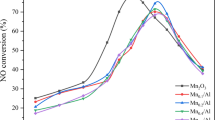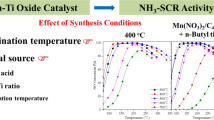Abstract
Nitric oxide (NOx), as one of the main pollutants, can contribute to a series of environmental problems, and to date the selective catalytic reduction (SCR) of NOx with NH3 in the presence of excess of O2 over the catalysts has served as one of the most effective methods, in which Mn-based catalysts have been widely studied owing to their excellent low-temperature activity toward NH3-SCR. However, the related structure-activity relation was not satisfactorily explored at the atomic level. By virtue of DFT+U calculations together with microkinetic analysis, we systemically investigate the selective catalytic reduction process of NO with NH3 over Mn3O4(110), and identify the crucial thermodynamic and kinetic factors that limit the catalytic activity and selectivity. It is found that NH3 prefers to adsorb on the Lewis acid site and then dehydrogenates into NH2* assisted by either the two- or three-fold lattice oxygen; NH2* would then react with the gaseous NO to form an important intermediate NH2NO that prefers to convert into N2O rather than N2 after the sequential dehydrogenation, while the residual H atoms interact with O2 and left the surface in the form of H2O. The rate-determining step is proposed to be the coupling reaction between NH2* and gaseous NO. Regarding the complex surface structure of Mn3O4(110), the main active sites are quantitatively revealed to be O3c and Mn4c.
Similar content being viewed by others
References
Voinov M. Electrochim Acta, 1982, 27: 833–835
Smirniotis PG, Peña DA, Uphade BS. Angew Chem Int Ed, 2001, 40: 2479–2482
Fernández-García M, Martínez-Arias A, Hanson JC, Rodriguez JA. Chem Rev, 2004, 104: 4063–4104
Grootendorst EJ, Verbeek Y, Ponec V. J Catal, 1995, 157: 706–712
Weimin W, Yongnian Y, Jiayu Z. Appl Catal A-Gen, 1995, 133: 81–93
Chang Y, McCarty JG. Catal Today, 1996, 30: 163–170
Stobbe ER, de Boer BA, Geus JW. Catal Today, 1999, 47: 161–167
Bell AT. Science, 2003, 299: 1688–1691
Yang HG, Sun CH, Qiao SZ, Zou J, Liu G, Smith SC, Cheng HM, Lu GQ. Nature, 2008, 453: 638–641
Kang M, Park ED, Kim JM, Yie JE. Appl Catal A-Gen, 2007, 327: 261–269
Xie J, Fang D, He F, Chen J, Fu Z, Chen X. Catal Commun, 2012, 28: 77–81
Kapteijn F, Singoredjo L, Andreini A, Moulijn JA. Appl Catal B-Environ, 1994, 3: 173–189
Yang S, Liao Y, Xiong S, Qi F, Dang H, Xiao X, Li J. J Phys Chem C, 2014, 118: 21500–21508
Yang S, Fu Y, Liao Y, Xiong S, Qu Z, Yan N, Li J. Catal Sci Technol, 2014, 4: 224–232
Kapteijn F, Singoredjo L, Vandriel M, Andreini A, Moulijn JA, Ramis G, Busca G. J Catal, 1994, 150: 105–116
Singoredjo L, Korver R, Kapteijn F, Moulijn J. Appl Catal B-Environ, 1992, 1: 297–316
Yang S, Wang C, Li J, Yan N, Ma L, Chang H. Appl Catal B-Environ, 2011, 110: 71–80
Kijlstra WS, Brands DS, Poels EK, Bliek A. J Catal, 1997, 171: 208–218
Chartier A, D’arco P, Dovesi R, Saunders VR. Phys Rev B, 1999, 60: 14042–14048
Franchini C, Podloucky R, Paier J, Marsman M, Kresse G. Phys Rev B, 2007, 75: 195128
Kresse G, Furthmüller J. Phys Rev B, 1996, 54: 11169–11186
Perdew JP, Ruzsinszky A, Csonka GI, Vydrov OA, Scuseria GE, Constantin LA, Zhou X, Burke K. Phys Rev Lett, 2008, 100: 136406
Kresse G, Joubert D. Phys Rev B, 1999, 59: 1758–1775
Alavi A, Hu P, Deutsch T, Silvestrelli PL, Hutter J. Phys Rev Lett, 1998, 80: 3650–3653
Liu ZP, Hu P. J Am Chem Soc, 2003, 125: 1958–1967
Michaelides A, Hu P. J Am Chem Soc, 2001, 123: 4235–4242
Liu ZP, Hu P, Alavi A. J Am Chem Soc, 2002, 124: 14770–14779
Hirai S, Goto Y, Sakai Y, Wakatsuki A, Kamihara Y, Matoba M. J Phys Soc Jpn, 2015, 84: 114702
Hammer B, Norskov JK. Adv Catal, 2000, 31: 71–129
Pallassana V, Neurock M. J Catal, 2000, 191: 301–317
Michaelides A, Liu ZP, Zhang CJ, Alavi A, King DA, Hu P. J Am Chem Soc, 2003, 125: 3704–3705
Marbán G, Valdés-Solís T, Fuertes AB. Phys Chem Chem Phys, 2004, 6: 453–464
NIST Chemistry WebBook. http://webbook.nist.gov/chemistry/. Accessed on 2017–08-26
Qi G, Yang RT, Chang R. Appl Catal B-Environ, 2004, 51: 93–106
Park KH, Lee SM, Kim SS, Kwon DW, Hong SC. Catal Lett, 2013, 143: 246–253
Yang S, Xiong S, Liao Y, Xiao X, Qi F, Peng Y, Fu Y, Shan W, Li J. Environ Sci Technol, 2014, 48: 10354–10362
Qi G, Yang RT. Appl Catal B-Environ, 2003, 44: 217–225
Stegelmann C, Andreasen A, Campbell CT. J Am Chem Soc, 2009, 131: 8077–8082
Campbell CT. J Catal, 2001, 204: 520–524
Qi G, Yang RT. J Catal, 2003, 217: 434–441
Acknowledgments
This work was supported by the National Natural Science Foundation of China (21333003, 21622305), Young Elite Scientist Sponsorship Program by China Association for Science and Technology (YESS20150131), “Shu Guang” project supported by Shanghai Municipal Education Commission and Shanghai Education Development Foundation (13SG30), and the Fundamental Research Funds for the Central Universities (WJ616007).
Author information
Authors and Affiliations
Corresponding authors
Rights and permissions
About this article
Cite this article
Yang, M., Yuan, H., Wang, H. et al. Insights into the selective catalytic reduction of NO by NH3 over Mn3O4(110): a DFT study coupled with microkinetic analysis. Sci. China Chem. 61, 457–467 (2018). https://doi.org/10.1007/s11426-017-9134-0
Received:
Accepted:
Published:
Issue Date:
DOI: https://doi.org/10.1007/s11426-017-9134-0




